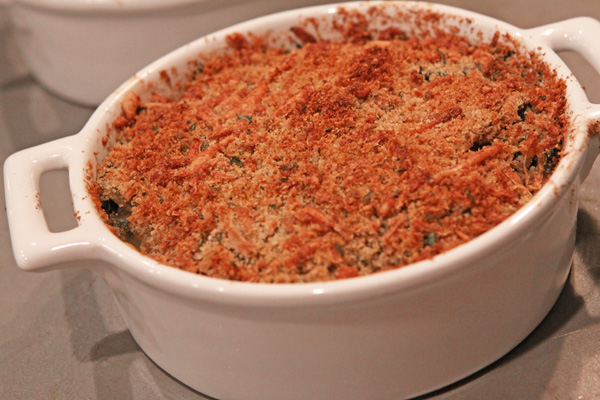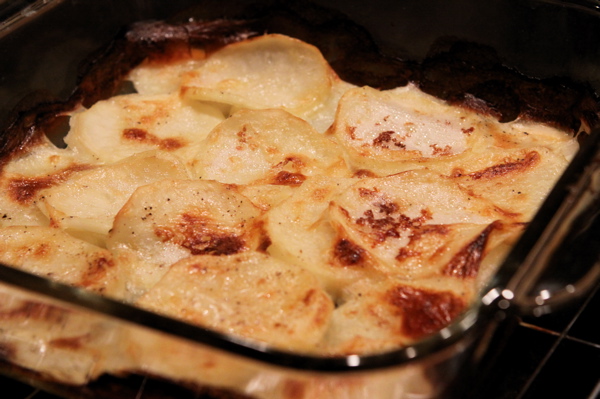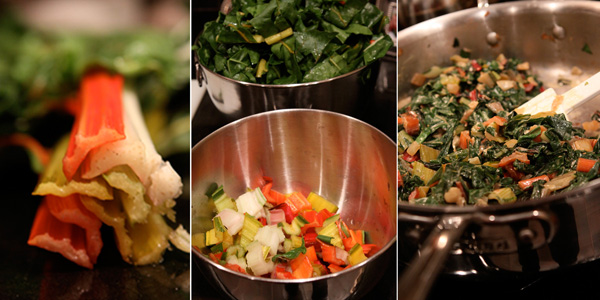
The minute the swiss chard gratin hit my tongue I was in a state of bewilderment. Those were chard greens that went into the dish, right? The dark greens with hearty leaves and firm stems, second cousin to my beloved spinach (which I placed on a pedestal long ago after experiencing its glory in salads and pastas)? Is chard actually giving spinach a run for its money?
And, wait a minute…this is a gratin? Isn’t a gratin supposed to involve potatoes in some way?
New Larousse Gastronomique declares that gratin simply means “a thin crust formed on the surface of certain dishes when they are browned in the oven or under the grill.” Further, while it is common to find potatoes cooked au gratin, any food (cooked or raw, vegetable or meat) can be prepared au gratin. The link in these recipes would be a cooking liquid (cream, milk, half and half, stock) and a topping that will brown and crust in the oven (grated cheese, bread crumbs or bread crumbs and egg).
Doesn’t that sound easy?
Recent experiments with potato gratin recipes suggest otherwise. The potato gratin recipe from the Chez Panisse Vegetables cookbook suggests layering 1/8 inch sliced potatoes in a baking dish with dabs of butter, applying salt and pepper between layers, and then filling the dish with the cooking liquid until it just moistens the top of the last layer. Sprinkle cheese on top and bake.
The result? A tasty-but-watery gratin filled with slightly firm potatoes. What went wrong?

More cooking generated these general guidelines for gratin baking and, as a result, the gratin above was made according to guidelines and with potato, parmesan and skim milk. Looks and taste are spot on; creamy and delicious.
1. Choose your dish wisely. The dish you bake the gratin in should be shallow, no deeper than 2 inches. A 9×13 or 9×9 dish is always a good bet, depending on the amount of gratin you are making.
2. Use the liquid sparingly. For a potato gratin, fill the dish with liquid just until the reaches the top layer, then press down firmly with a spatula to immerse this final layer in the liquid. You can always repeat this halfway through the baking as well. With other gratins, such as the aforementioned swiss chard gratin, or this mushroom gratin, you need only a small amount of liquid. These vegetables are already cooked, therefore you are just moistening them with the liquid. The crust on top will keep them from drying out in the oven.
3. Slice thinly and limit your layers. In particular for the potato or other root vegetable gratin, slices should be ultra thin (1⁄8 inch) and the gratin should sit no higher than two layers to ensure even cooking and that the liquid can be absorbed. If you are doubling a recipe, consider using a larger dish or a second dish rather than presuming that the more layers, the merrier. For the swiss chard and mushroom gratin, this does not apply.
Gratin 101 is now complete. Next week…scalloped potatoes. (For the record, scalloped just means a creamed casserole dish…well, let’s stop there).
But back to that swiss chard gratin. A far cry from your potatoes au gratin, this gratin has beautiful texture derived from the wilted leaves and the hearty, softened stems. It also features tangy gruyere, a barely-there cream sauce, and a beautiful golden breadcrumb crust it is, in a word, irresistible.
If you’re not inclined to make one a gratin at home try the Blackbird Cafe, which lists a ham and scalloped potatoes (with yukon gold potato gratin) dish on their dinner menu, and The Sample Room, which lists a fire roasted artichoke gratin within their sample plates dinner selections.

Swiss Chard Gratin
Serves 4
recipe adapted from Gourmet 2001
and thanks to Kristin at The Kitchen Sink Recipes for steering me toward it
4 tablespoons unsalted butter
½ cup fresh white bread crumbs
½ oz Tomme de Savoie or Gruyère cheese, grated (1/2 cup)
1 garlic clove, halved lengthwise, germ removed if green, and garlic finely chopped
2 teaspoons finely chopped flat-leaf parsley
1⁄8 teaspoon freshly grated nutmeg
½ cup low-sodium chicken broth
¼ cup heavy cream
2 teaspoon all-purpose flour
1 small onion, finely chopped
2 lb Swiss chard, leaves and stems separated and both cut into 1-inch pieces*
Melt 1 tablespoon butter and toss with bread crumbs, cheese, garlic, herbs, half of nutmeg, and salt and pepper to taste in a bowl.
Boil broth in a small saucepan until reduced by half. Add cream and keep warm.
Melt 1 tablespoon butter in a small heavy saucepan over moderate heat and stir in flour. Cook roux, whisking, 1 minute, then whisk in broth mixture and boil, whisking, 1 minute. Season sauce with salt and pepper.
Preheat oven to 400°F.
Cook onion in remaining 2 tablespoons butter in a wide heavy pot over moderately low heat, stirring, until softened. Add chard stems, remaining nutmeg, and salt and pepper to taste and cook, stirring, until vegetables are tender but not browned, about 8 minutes.
Increase heat to moderately high and add chard leaves and spinach by large handfuls, stirring, until all greens are wilted. Season with salt and pepper.
If there is liquid, transfer vegetables to a colander to drain well and press out liquid with back of a large spoon. Toss vegetables with cream sauce (it will seem like there is barely enough) and transfer to a buttered oval gratin or shallow baking dish, spreading evenly.
Top vegetables with bread crumbs and bake in middle of oven until bubbling and topping is golden, about 20 minutes.
*This beautiful, organic rainbow chard was purchased at The Seward Co-op.

I’m a huge fan of swiss chard and definitely favor it to spinach. Spinach is almost ubiquitous at this point, but doesn’t deserve the credit it gets, in my opinion. Often, I don’t enjoy the way that it makes my teeth feel. Good point on the swiss chard!